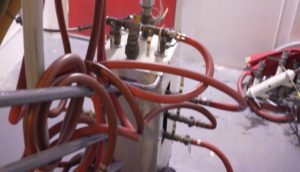You have choices where re-piping your home is concerned. It’s possible, in fact, to restore the pipes you already have to better than new condition with a system called ePIPE and today we’re gonna learn about ePIPE. What it is, how it works and what you can expect from it. And to cover all that ground, we’re joined by Gary Gold with TDT Plumbing. He’s an expert in leak detection, re-piping and pipe restoration. He’s a recognized expert on ePIPE and he’s here to explain how it works.
Transcript:
GARY: Thanks Charlie.
CHARLIE: So, let’s start with ePIPE itself. What exactly is ePIPE?
What is ePIPE technology?
GARY: ePIPE is an epoxy coating technology. So, the goal is to coat the inside of your pipes with a two part epoxy resin that will seal and harden inside of your old pipes.
CHARLIE: So, what we get now is almost a pipe within a pipe?
GARY: Absolutely.
CHARLIE: So, not only are we fixing the pipe, we’re also fixing all those connections along the way.
GARY: Absolutely.
CHARLIE: The thing that drives us, I imagine, would be leaks in the pipe.
Why do you need to repipe a house?
GARY: Sure, there are several things that causes people to wanna go out and replace or repair or re-pipe their homes or it could be an office building or both, right? Could be anything, anything with pipes. So, pinhole leaks is a problem. You come home from a hard day at work and you’ve got water in your ceiling and drywall falls in. You have a pinhole leak. That’s usually the driving force. Pipes, the fittings, the connectors, older homes have galvanized steel pipe and those are threaded and often you’ll have rusty water and you probably experience where you go on a trip, come back to your house, you turn on the water and it’s long horned orange, right? It’s nice and rusty.
CHARLIE: Perish the thought.
GARY: And that’s exactly why people say, “Hey, we need to do something about this. My white clothes are rusty clothes.”
CHARLIE: Mm-hmm (affirmative).
GARY: Or, “I have a leak, it’s causing damage and ruined my hardwood floors.” And so that’s where we come in with the technology.
CHARLIE: So, these are problems not just for a home but you could have this in an office building, an apartment complex, anywhere and this ePIPE technology will work in all those places.
GARY: We use it in anything that you’d consider pressurized pipes. So, it’s domestic water primarily, so hot and cold water piping systems. So, the guys that use the most water and have the most high volume use are like hotels, schools, office buildings. Those are good spots. Residential homes as they get older, 20 years, 30, 40 years old and older, those are great candidates and we also do gas lines and we can do hydronic lines for chilled water lines. Different types of pipes but they’re usually all under pressure.
CHARLIE: So, let’s get down to that whole idea of the way the process works. You said that you epoxy coat the inside of the pipe, what’s the process for making that happen.
How does the ePIPE epoxy coating process work?
GARY: The whole process starts with isolating segments. Let’s say, for instance, to simplify just the hot water lines in a home. So, we disconnect all of the supply lines and we blow air through those pipes and we kind of convection bake the corrosion and the rust and everything that’s on the inside. We get it really, really hot, we blow it dry and we get it to where we can sand blast the inside of the pipe. Pretty neat idea to come into these half inch tubes and pipes and to sand blast and clean the corrosion, the calcium. It can be certainly big chunks of rust and we sand blast it out of the inside of the pipe, getting down to bare material. Once we do that, it opens them up. It’s kind of like an angioplasty that you might have on your heart. We do it to the house and it’s vital, it’s vital for the plumbing system of the home. Get it nice and clean and then we blow in the epoxy resin from each and every connection that we have isolated and what that does is it wets the inside of that pipe and it’s a permanent solution. Epoxies are so much stronger than galvanized coatings. They’re so much stronger than bare copper pipe and that’s normally where you see us using the product in a steel pipe or a copper pipe.
CHARLIE: So, you’re gonna end up with pipes that are literally better than they were when they were new.
GARY: Without a doubt. The technology’s proven and we know for a fact that a resin coated, epoxy coated pipe will outlast anything.
CHARLIE: Gary, do you get questions and that, that resin epoxy thing, and you’re gonna run drinking water through, I mean, how safe is it?
 GARY: It’s safe enough that we actually have patents that are in place for the anti-leaching of lead, copper, heavy metals, in to the drinking water. So, we’re sealing the pipe from the inside and putting an inert barrier between the wall of the pipe and the water itself. Super inert, super clean, like plastic, like a CPVC, PVC pipe but cleaner. I mean, it’s just super, super clean and to come into a place that has contaminated drinking water, maybe lead contamination, to be able to patent the process of sealing, prevent the corrosion and erosion from happening, that’s what it’s all about. It’s good stuff.
GARY: It’s safe enough that we actually have patents that are in place for the anti-leaching of lead, copper, heavy metals, in to the drinking water. So, we’re sealing the pipe from the inside and putting an inert barrier between the wall of the pipe and the water itself. Super inert, super clean, like plastic, like a CPVC, PVC pipe but cleaner. I mean, it’s just super, super clean and to come into a place that has contaminated drinking water, maybe lead contamination, to be able to patent the process of sealing, prevent the corrosion and erosion from happening, that’s what it’s all about. It’s good stuff.
CHARLIE: Is ePIPE right for every situation then, Gary? I mean, are there situation where it doesn’t make sense?
GARY: There certainly are. What we look at is from a case to case basis. Sometimes re-pipes, conventionally, make sense. For instance, after Harvey hit, you have a lot of houses, walls were torn out, you’ve got great access and maybe faster ways to re-pipe and we might steer you in that direction. There are obviously other places it makes complete sense, it’s the right way to go but either way, our company can come in and we could look at that together, make some decisions of what would make sense and then you go from there. You make the right decision and we position that.
CHARLIE: You touched on the idea of having to open up the walls to re-pipe, how much opening up of walls do you have to do for the ePIPE system?
GARY: That’s what’s nice about it. Actually, that’s one of the things that’s nice about it. As far as the epoxy coating technologies, we access those lines where they come out of the wall already. We’re using that host pipe and applying that continuous barrier coating to the inside so we don’t typically have to get into the wall. So, if you have a nicely painted wall with drywall and wallpaper or whatever, we don’t have to cut into that wall to get to it, with the exception of just a few locations like at a tub fixture. Tubs are the only place in a home that typically the pipes don’t come out of the wall so we gotta touch it depending on the valve, the style. We may go from one side of the wall or the other. We’re gonna need to touch that. But compared to a re-pipe, let’s say a re-pipe, you have 10 holes or 30 holes or even more in a decent size home, we’re talking about many one or two or three locations. Huge difference. And the speed and the timing is fantastic.
CHARLIE: Yeah, I was gonna ask you. How long does this process take?
How long does the ePIPE process take?
GARY: Most of the homes, if you’re looking at a residential setting, we often will start on Monday and depending on the size, we finish Wednesday, Thursday, maybe sometimes Friday. So, three to five days is very typical. Bigger properties, however, we have a few 125 unit kind of like hotel style, those we may work on them for up to a year. Isolating sections at a time, letting people live there and continue to do business as usual and we will restore that pipe over time in a very convenient manner.
CHARLIE: When you come to my house, am I gonna lose all use of my water while you’re doing this?
GARY: To your home, Charlie, yep, you will lose your water.
CHARLIE: Okay. No but I’m saying it’s only a few days but how does that impact my day to day life in the house while you’re doing it?
GARY: Again, typically, we’re gonna turn the water off. The primary plumbing system of the home will be without water. There certainly are ways for us to get water to commode fixtures. Everybody has bottom water. Most often, our clients never leave the residence. They’re not gonna go somewhere. Although, from time to time, we have folks that will say, “Hey, I’m on vacation from October the 25th to the 30th, can you do my house?” And we will. It’s perfect but you’re without hot and cold water, let’s say, your lavatories or whatever but we’ll give you some water so that you can use some fixtures.
CHARLIE: Okay, cool. Well, that sounds like it’s a lot less inconvenient than the longer re-piping process. Are there other alternative to this? I mean, is PEX an alternative to doing this, Gary?
GARY: Oh certainly. Everybody, do your research, work with folks like us, look at the piping system. A one story house has a better solution than a two story house when it comes to a re-pipe. You can re-pipe with copper. People do it with CPVC PEX, that’s another product that people re-pipe all the time with. New construction homes are being put in using typically PEX or CPVC. We, actually, we’re re-piping copper if you would like to go to another metallic pipe. So, there are options out there and we’re here to help with those.
CHARLIE: So you have the ePIPE and you have these other re-piping options as well.
GARY: Absolutely.
CHARLIE: All right. You can learn more about ePIPE and the other re=piping and plumbing restoration options that they have available from TDT Plumbing on the website. In case you needed it, it’s tdtplumbing.com. Gary, thanks for taking time to help us understand this process today.
GARY: Thank you, Charlie, have a good day.
